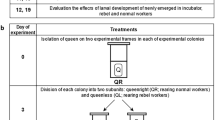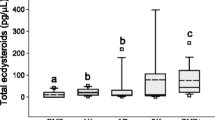Summary
The influence of juvenile hormone (JH) on the behaviour of the female honeybee larva (Apis mellifera L.) during ultimate orientation was investigated. The effect of gravity was tested in natural and artificial cells by changing their inclination and by rotation experiments.
In queen larvae ultimate orientation (final orientation at the outset of metamorphosis) is controlled by gravity. They display a positive geotaxis under all experimental conditions tested even in reversed natural cells. However, ultimate orientation of worker larvae in natural cells is not affected by gravity. A positive geotactic preference is shown only in long artificial cells whereas larvae in short cells respond indifferently to gravity. The texture of the cell ending has a directing effect.
The geotactic indifference is replaced by a positive geotaxis in worker larvae treated with JH-I or JH-III during the third day of larval development (Fig. 5). In JH-treated larvae the evaluation of gravity equals that of queen larvae (Fig. 7). A positive geotaxis is evoked even in individuals that develop rather weak adult queenlike characteristics (Table 2). The juvenile hormone titer not only controls the differentiation of morphological and anatomical caste characteristics but also affects the orientation behaviour of the spinning larva.
Similar content being viewed by others
Abbreviations
- JH :
-
juvenile hormone
- QI :
-
queen index
References
Asencot, M., Lensky, Y.: The effect of sugars and juvenile hormone on the differentiation of the female honeybee larvae (Apis mellifera L.) to queens. Life Sci.18, 693–700 (1976)
Benz, G.: Reversal of spinning behaviour in last instar larvae ofPieris brassicae treated with JH derivates. Experientia29, 1437–1438 (1973)
Cooper, K.W.: Biology of eumenine wasps. V. Digital communication in wasps. J. Exp. Zool.134, 469–514 (1957)
Copijn, G.M., Beetsma, J., Wirtz, P.: Queen differentiation and mortality after application of different juvenile hormone analogues to worker larvae of the honeybee (Apis mellifera L.). Proc. K. Ned. Akad. Wet.82C, 29–42 (1979)
Crozier, W.J., Stier, T.J.B.: Geotropic orientation in arthropods I.Malacosoma larvae. J. Gen. Physiol.11, 803–821 (1928)
Dietz, A., Hermann, H.R., Blum, M.S.: The role of exogenous JH-I, JH-III and Anti-JH (Precocene II) on queen induction of 4.5 day old worker honey bee larvae. J. Insect Physiol.25, 503–512 (1979)
Ebert, R.: Juvenilhormon-Applikationen bei der weiblichen Honigbienenlarve (Apis mellifera carnica Pollm.) und deren Auswirkungen auf die Entwicklung zur Imago. Dimplomarbeit, Fachbereich Biologie der J.-W.-Goethe-Universität, Frankfurt am Main (1976)
Fyg, W.: Beitrag zur Kenntnis der larvalen Hautsinnesorgane der Honigbiene (Apis mellifera L.). Mitt. Schweiz. Entomol. Ges.38, 184–192 (1966)
Goewie, E.A., Beetsma, J.: Induction of caste differentiation in the Honey Bee (Apis mellifera L.) after topical application of JH-III. Proc. K. Ned. Akad. Wet.79C, 466–469 (1976)
Gontarski, H.: Die Orientierung der Larve vonApis mellifica in der geschlossenen Zelle. I. Dorsoventrale Orientierung. Z. Bienenforsch.3, 216–220 (1957)
Gross, F.: Zur Bedeutung des Oberschlundganglions beim Spinnverhalten von Raupen. Zool. Jahrb. Physiol.68, 535–538 (1960)
Hirashima, Y.: Comparative studies on the cocoon spinning habits ofOsmia excavata Alfken andOsmia pedicornis Cockerell (Hymenoptera Megachilidae). Sci. Bull. Fac. Agric. Kyushu16, 481–497 (1958)
Horn, E.: The contribution of different receptors to gravity orientation in insects. Fortschr. Zool.23, 1–20 (1975a)
Horn, E.: Mechanisms of gravity processing by leg and abdominal gravity receptors in bees. J. Insect Physiol.21, 673–679 (1975b)
Huber, F.: Neue Beobachtungen an den Bienen. Nach der zweiten Ausgabe. Deutsch mit Anmerkungen von Georg Kleine. 2. Heft: Bienenleben und Bienenzucht, pp. 166–170. Einbeck: Ehlers 1856
Ishay, J.: Orientation by pupating larvae ofVespa orientalis. Insectes Soc.22, 67–74 (1975)
Jander, R.: Grundleistungen der Lichtund Schwereorientierung von Insekten. Z. Vergl. Physiol.47, 381–430 (1963)
Jay, S.C.: The longitudinal orientation of larval honey bees in their cells. Can J. Zool.41, 717–723 (1963)
Jay, S.C.: Starvation studies of larval honey bees. Can. J. Zool.42, 455–462 (1964)
Kloot, W.G van der, Williams, C.M.: Cocoon construction by theCecropia silkworm. I. The role of the external environment. Behaviour5, 141–156 (1953a)
Kloot, W.G. van der, Williams, C.M.: Cocoon construction by theCecropia silkworm. II. The role of the internal environment. Behaviour5, 157–174 (1953b)
Kloot, W.G. van der, Williams, C.M.: Cocoon construction by theCecropia silkworm. III. The alteration of the spinning behaviour by chemical and surgical techniques. Behaviour5, 235–255 (153c)
Lawrence, P.A.: The hormonal control of the development of hairs and bristles in the milkweed bug.Oncopeltus fasciatus. Dev. Biol.19, 12–40 (1969)
Lensky, Y., Baehr, J.-C., Porcheron, P.: Dosages radio-immunologiques des ecdysones et des hormones juvéniles au cours du développement post-embryonnaire chez les ouvrières et les reines d'Abeille (Apis mellifica L. var. ligustica). C.R. Acad. Sci. [D] (Paris)287, 821–824 (1978)
Lindauer, M., Nedel, J.O.: Ein Schweresinnesorgan der Honigbiene. Z. Vergl. Physiol.42, 334–364 (1959)
Lukoschus, F.: Über Hautsinnesorgane der Bienenlarve (Apis mellifica). Z. Bienenforsch.3, 85–87 (1955)
Lukoschus, F.: Zur Kastendetermination bei der Honigbiene. Z. Bienenforsch.3, 190–199 (1956)
Markl, H.: Borstenfelder an den Gelenken als Schweresinnesorgane bei Ameisen und anderen Hymenopteren. Z. Vergl. Physiol.45, 475–569 (1962)
Martin, H., Lindauer, M.: Sinnesphysiologische Leistungen beim Wabenbau der Honigbiene. Z. Vergl. Physiol.53, 372–404 (1966)
Matthews, R.W., Kislow, C.J.: Cocoon orientation in a megachilid bee: larval response to pollen placement. Environ. Res.2, 157–158 (1973)
Michener, C.D.: Biologies of African allodopine bees (Hymenoptera, Xylocopinae). Bull. Am. Mus. Nat. Hist.145, 219–301 (1971)
Piepho, H.: Hormonale Grundlagen der Spinntätigkeit bei Schmetterlingsraupen. Z. Tierpsychol.7, 424–434 (1950)
Piepho, H.: Juvenilhormon und Verhalten bei der Wachsmotte. Naturwissenschaften54, 50 (1967)
Piepho, H., Böden, E., Holz, I.: Über die hormonale Abhängigkeit des Verhaltens von Schwärmerraupen vor den Häutungen. Z. Tierpsychol.17, 261–269 (1960)
Sachs, L.: Angewandte Statistik, Planung und Auswertung — Methoden und Modelle. Berlin, Heidelberg, New York: Springer 1974
Schafer, R., Sanchez, T.: The nature and development of sex attractant specificity in cockroaches of the genusPeriplaneta II. Juvenile hormone regulates sexual dimorphism in the distribution of antennal olfactory receptors. J. Exp. Zool.198, 323–336 (1976)
Sehnal, F.: Einfluß des Juvenilhormons auf die Metamorphose des Oberschlundganglions beiGalleria mellonella. Zool. Jahrb.71, 659–664 (1965)
Shuel, R.W., Dixon, S.E., Kinoshita, G.B.: Growth and development of honeybees in the laboratory on altered queen and worker diets. J. Apic. Res.17, 57–68 (1978)
Truman, J.W., Riddiford, L.M.: Hormonal mechanisms underlying insect behaviour. Treherne, J.E., Berridge, M.J., Wigglesworth, V.B. (eds.), pp. 297–352. London, New York: Academic Press 1974
Velich, A.V.: Entwicklungsmechanische Studien an Bienenlarven. Z. Wiss. Zool.136, 210–222 (1930)
Wiedbrauck, J.: Vom Spinnen bei Schmetterlingsraupen und seiner Abhängigkeit von Metamorphosehormonen. Z. Tierpsychol.12, 176–202 (1955)
Wilde, J. de, Boer, J.A. de: Humoral and nervous pathways in photoperiodic induction of diapause inLeptinotarsa decemlineata. J. Insect Physiol.15, 661–675 (1969)
Wirtz, P.: Differentiation in the honey bee larva. Meded. Landbouwhogeschool Wageningen73–5 (1973)
Wirtz, P., Beetsma, J.: Induction of caste differentiation in the honeybee (Apis mellifera L.) by juvenile hormone. Ent. Exp. Appl.15, 517–520 (1972)
Zander, E., Becker, F.: Die Ausbildung des Geschlechtes bei der Honigbiene. II. Erlanger Jahrb. Bienenkunde3, 161–246 (1925)
Author information
Authors and Affiliations
Additional information
My special thanks are due to Prof. Dr. M. Lindauer (Würzburg) for providing all facilities in the performance of this study. I am grateful to him and Dr. E. Horn (Karlsruhe) for fruitful discussions and to Drs. J. Beetsma and M. Brouwers (Wageningen) for critically reading the manuscript. The JH-I was a gift from Prof. Hainaut, Roussel-Uclaf (Romainville/France). The study was supported by a fellowship of the ‘Studienstiftung des Deutschen Volkes’.
Rights and permissions
About this article
Cite this article
Ebert, R. Influence of juvenile hormone on gravity orientation in the female honeybee larva (Apis mellifera L.). J. Comp. Physiol. 137, 7–16 (1980). https://doi.org/10.1007/BF00656912
Accepted:
Issue Date:
DOI: https://doi.org/10.1007/BF00656912




